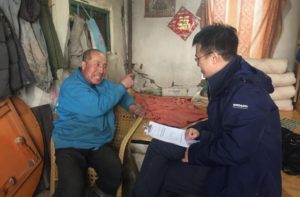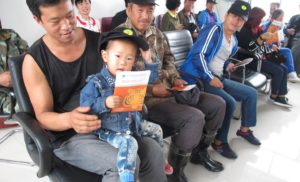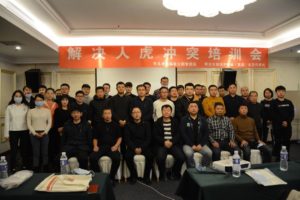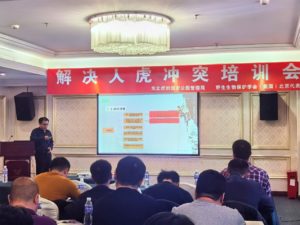Wildlife conflict is a growing problem in many areas where wild habitats have shrunk and potentially dangerous animals increasingly come into contact with people. Conflict increases when this is also combined with conservation efforts to recover populations of predators such as tigers that are facing extinction.
Conservation projects must take conflict mitigation seriously and work with National Parks and communities to put in place the appropriate measures to protect both wildlife and people to enable coexistence.
In 2018, WCS carried out a range of activities funded by WildCats Conservation Alliance in the Hunchun Nature Reserve in China, part of the larger Tiger and Leopard National Park (TLNP). Local people from 49 villages in the park and 7 towns and cities from the vicinity were interviewed to learn about their understanding of wildlife conflict. The results show that most villagers have a high awareness of wildlife protection, while some people have a negative view of wildlife, especially wild boars and tigers. Most villagers were familiar with the compensation policy for damages to property caused by wildlife, but they knew little about how to avoid conflict or reduce the threat to themselves or their property.
Armed with this information WCS developed a booklet on conflict resolution. It was based on a conflict mitigation booklet created in Russia (including how to correctly understand conflict situations, how to avoid unnecessary conflict, and how to stay safe) but revised to reflect societal and cultural differences. The booklet was distributed and promoted through a series of local workshops attended by over 400 residents.
These activities were due to be followed in 2019 by a technical training session in Russia to which Chinese National Park staff would attend to foster cross border collaboration. Administrative delays were followed by the appearance of the COVID-19 pandemic and the training session funded by WildCats Conservation Alliance was put off again.
Finally, the session was held, not in Russia but in Hunchun. On December 24, 2020, WCS and TLNP jointly held the “Human-Tiger Conflict Resolution Training Conference”. The training was conducted for 6 branches of TLNP in Jilin Province (4 branches in Heilongjiang Province were unable to participate in the training due to covid-19 travel restrictions).
The first part of the training course was conducted by TLNP Administration and explained the “Emergency Plan for Amur Tiger and Leopard Incidents” issued in January 2020. This plan includes an overview of how incidents are classified, which responses are appropriate, and how to handle a timely flow of information.
Next, WCS summarized anaesthesia methods used by the Wildlife Rescue Center, and related experiences of field anaesthesia from both WCS Russia and China teams. Finally, an expert from the Feline Research Center of the National Forestry and Grassland Administration gave a detailed explanation of his own experiences in handling conflicts in recent years, wild animal rescue, and how to effectively carry out wild animal rescue work. According to WCS the meeting “also included ample time for discussion, where members of different park branches were able to discuss varying problems unique to their branches”.
Despite the delay, this conference has had positive outcomes as the home location resulted in more of the TLNP staff being able to attend. WCS China has also published the Tiger and Leopard Field Anaesthesia Procedure Manual to help better protect the tigers and Amur leopards that live in this region.

Interviews for questionnaires in 2018 with local residents © WCS

Conflict mitigation © WCS China

Participants at the conflict conference in 2020 © WCS

Presentations at the conference from TLNP © WCS

